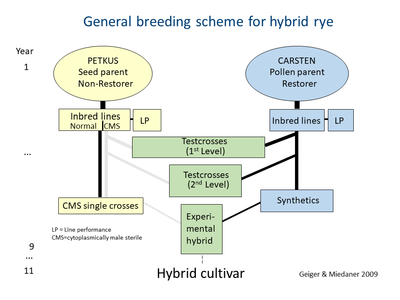Rye
Resource- and environment-friendly crop production requires crops that are also efficient under abiotic stress conditions and have a high resistance to biotic pests. Rye is predestined for this in several ways. It is highly drought tolerant, nutrient efficient and inherently more resistant to fungal pathogens than other cereals. As a hybrid, it is also particularly efficient, with yields comparable to triticale and wheat even on medium to good soils.
Our work focuses on the further development of breeding methods for hybrid rye and resistance to biotic stresses in rye and, in collaboration with other working groups, in wheat, triticale and maize. More specifically, we are working on the following issues:
1 Methodological development of hybrid breeding in rye
- Improving the restoration of pollen fertility through the introgression of genes from genetic resources
- Genetic and molecular studies on the suitability of rye varieties for biomass production
2 Quantitative genetic analysis of host-pathogen populations, including mycotoxins
- Estimation of population parameters for resistance to stem rust, Fusarium head blight and ergot in rye
- Genetic analysis of host populations (wheat, triticale, maize) for Fusarium resistance
3 Genome-based plant breeding and population genetics
- QTL mapping and genome-wide association mapping (GWAS) to find and verify genes/quantitative trait loci (QTL) for resistance to stem rust in rye, Fusarium head blight in small grains and Giberella ear rot in maize.
- Genome-based strategies for the detection and utilisation of multiresistant genotypes of wheat and triticale against yellow and stem rust and Fusarium head blight
- Marker-assisted analysis of Fusarium population diversity and genetic mapping of pathogenicity, aggressiveness and mycotoxin production in Fusarium

